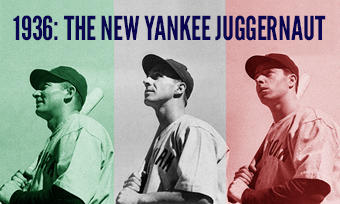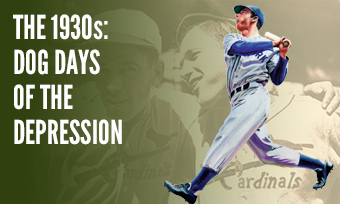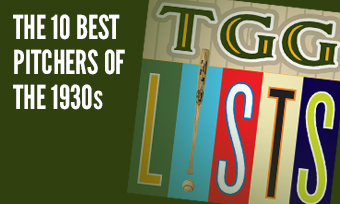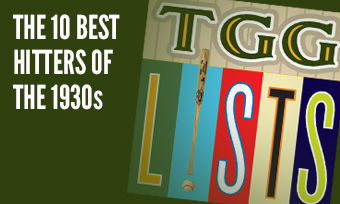The Yearly Reader
Leaders and Honors, 1936
Our list of baseball’s top 10 hitters and pitchers in both the American League and National League for the 1936 baseball season, as well as the awards and honors given to the game’s top achievers of the year.
The National League’s Top 10 Hitters, 1936
Bold type in brick red indicates league leader.
1. Mel Ott, New York
Key Numbers: .328 average, 120 runs, 28 doubles, 33 home runs, 135 RBIs, 111 walks, 21 intentional walks, .588 slugging percentage.
It seems hard to believe considering his preponderance for power, but Ott led the NL in slugging percentage for the one and only time in his illustrious career.
2. Joe Medwick, St. Louis
Key Numbers: .351 average, 115 runs, 223 hits, 64 doubles, 13 triples, 18 home runs, 138 RBIs.
Medwick hit 40 of his NL-record 64 doubles after the All-Star Break.
3. Dolph Camilli, Philadelphia
Key Numbers: .315 average, 106 runs, 29 doubles, 13 triples, 28 home runs, 102 RBIs, 116 walks.
Camilli, whose brother died in a boxing bout against Max Baer, thought the better of continuing his own boxing career and slugged baseballs out of the park at an increasing rate for the Phillies.
4. Paul Waner, Pittsburgh
Key Numbers: .373 average, 107 runs, 218 hits, 53 doubles, 9 triples, 5 home runs, 94 RBIs, 74 walks.
Big Poison failed to reach double-figures in triples for the first time in his career, but did earn his third (and final) official NL batting title.
5. Arky Vaughan, Pittsburgh
Key Numbers: 156 games, .335 average, 122 runs, 190 hits, 30 doubles, 11 triples, 9 home runs, 78 RBIs, 118 walks, .453 on-base percentage.
The nifty third-sacker from Clifty, Arkansas continued to be a pest for opposing pitchers as he led the NL in on-base percentage for the third straight year.
6. Gus Suhr, Pittsburgh
Key Numbers: 156 games, .312 average, 111 runs, 182 hits, 33 doubles, 12 triples, 11 home runs, 118 RBIs, 95 walks.
Rewarding himself with his dutiful attendance, Suhr set career bests in many categories while leading the NL in games played for a fifth straight year.
7. Johnny Mize, St. Louis
Key Numbers: 126 games, .326 average, 30 doubles, 8 triples, 19 home runs, 93 RBIs, 21 intentional walks.
Mize could have been property of the Reds—actually, he was theirs for a brief time a year earlier, before returning him back to the Cardinals because of a groin injury. If only they knew.
8. Chuck Klein, Chicago-Philadelphia
Key Numbers: .306 average, 102 runs, 184 hits, 35 doubles, 7 triples, 25 home runs, 104 RBIs.
The once-and-current Phillie happily showed you could go home again.
9. Billy Herman, Chicago
Key Numbers: .334 average, 101 runs, 211 hits, 57 doubles, 7 triples, 5 home runs, 93 RBIs.
Herman finished second to Medwick’s 64 doubles with 57 of his own—tied for the fifth highest output of two-baggers in NL history. The man Herman tied was himself, from a year before.
10. Pepper Martin, St. Louis
Key Numbers: .309 average, 121 runs, 177 hits, 36 doubles, 11 triples, 11 home runs, 76 RBIs, 23 stolen bases.
Arguably the best set of numbers for the Wild Horse of the Osage, a year before a serious knee injury curtailed his output for the rest of his career.
The American League’s Top 10 Hitters, 1936
1. Lou Gehrig, New York
Key Numbers: 155 games, .354 average, 167 runs, 205 hits, 37 doubles, 7 triples, 49 home runs, 152 RBIs, 130 walks, .478 on-base percentage, .696 slugging percentage.
If not off the field, Joe DiMaggio certainly became Gehrig’s best new friend on it, as the star rookie’s presence greatly benefited the Iron Horse in the Yankee lineup.
2. Jimmie Foxx, Boston
Key Numbers: 155 games, .338 average, 130 runs, 198 hits, 32 doubles, 8 triples, 41 home runs, 143 RBIs, 105 walks, 119 strikeouts, 13 stolen bases.
A change of scenery didn’t affect Foxx’s prodigious numbers—although his 119 strikeouts were the most by any big leaguer since 1914.
3. Hal Trosky, Cleveland
Key Numbers: .343 average, 124 runs, 216 hits, 45 doubles, 9 triples, 42 home runs, 162 RBIs.
After a switch-hitting experiment muddied up his 1935 numbers, Trosky returned to left-handed form and averaged over an RBI per game; he also fashioned together the year’s longest hitting streak at 28 games.
4. Earl Averill, Cleveland
Key Numbers: .378 average, 136 runs, 232 hits, 39 doubles, 15 triples, 28 home runs, 126 RBIs.
A comeback to top form and then some, as Averill hit for a career-best average while easily increasing all of his power numbers.
5. Charlie Gehringer, Detroit
Key Numbers: .354 average, 144 runs, 227 hits, 60 doubles, 12 triples, 15 home runs, 116 RBIs, 83 walks.
Gehringer’s 60 doubles—making him the last AL player to date to reach the milestone—didn’t include a 61st rapped at the All-Star Game.
6. Luke Appling, Chicago
Key Numbers: .388 average, 111 runs, 204 hits, 31 doubles, 7 triples, 6 home runs, 128 RBIs, 85 walks, 10 stolen bases.
No other player in a White Sox uniform—Joe Jackson included—has ever hit higher than Appling did in 1936.
7. Bill Dickey, New York
Key Numbers: 112 games, .362 average, 99 runs, 26 doubles, 8 triples, 22 home runs 107 RBIs.
Dickey’s .362 batting average—an 83-point jump from the year before—was the highest batting average recorded by an American League catcher—though by today’s rules he would have fallen just short of qualifying. (Joe Mauer eventually topped Dickey’s mark in 2009.)
8. John Stone, Washington
Key Numbers: 123 games, .341 average, 95 runs, 22 doubles, 11 triples, 15 home runs, 90 RBIs.
The red-haired veteran finished a superlative season at Washington with a five-hit performance, including two triples, on the season’s final day against the Yankees.
9. Joe DiMaggio, New York
Key Numbers: 138 games, .323 average, 132 runs, 206 hits, 44 doubles, 15 triples, 29 home runs, 125 RBIs.
Joltin Joe’s belated start to the season likely kept him from a higher ranking on this list; he certainly tried to make up for lost time, as evidenced with a June game at Chicago where he became the first Yankee to belt two home runs in one inning.
10. Zeke Bonura, Chicago
Key Numbers: .330 average, 120 runs, 194 hits, 39 doubles, 7 triples, 12 home runs, 138 RBIs, 84 walks.
Bonura his more home runs at Philadelphia’s Shibe Park (five, in 11 games) than he did at his own home field (the more voluminous Comiskey Park).
The National League’s Top 10 Pitchers, 1936
1. Carl Hubbell, New York
Key Numbers: 2.31 ERA, 26 wins, 6 losses, .813 win percentage, 42 appearances, 34 starts, 25 complete games, 304 innings, 57 walks, 12 intentional walks.
For the fifth time in six years, Hubbell was the toughest pitcher to get reach safely against by allowing a .276 on-base percentage.
2. Danny MacFayden, Boston
Key Numbers: 2.87 ERA, 17 wins, 13 losses, 37 appearances, 32 starts, 21 complete games, 266.2 innings.
After years of relying on a fastball that seldom got him south of a 5.00 ERA, Danny MacFayden mixed up his selection and started a string of four straight years under the 3.00 mark—and helped in bringing the Bees (nee Braves, temporarily) back to respectability.
3. Van Lingle Mungo, Brooklyn
Key Numbers: 3.35 ERA, 18 wins, 19 losses, 45 appearances, 37 starts, 22 complete games, 311.2 innings, 118 walks, 238 strikeouts.
Van Lingle Mungo wasn’t the latest dance craze but the frustrated workhorse who threatened to leave Brooklyn if Dodgers hitters didn’t start backing him up.
4. Dizzy Dean, St. Louis
Key Numbers: 3.17 ERA, 24 wins, 13 losses, 11 saves, 51 appearances, 34 starts, 28 complete games, 315 innings, 53 walks, 195 strikeouts.
Perhaps because his brother Paul collapsed under the weight of injury, the hard-working Dizzy tried to do the work of two men—and easily accomplished it by leading the Cardinals both in wins and saves.
5. Bill Lee, Chicago
Key Numbers: 3.31 ERA, 18 wins, 11 losses, 43 appearances, 33 starts, 4 shutouts, 258.2 innings, 12 intentional walks.
Hair and eyebrows above the rest of a solid Cubs rotation, Lee was one of four pitchers on the team to co-lead the NL with four shutouts.
6. Frank Gabler, New York
Key Numbers: 3.12 ERA, 9 wins, 8 losses, 6 saves, 43 appearances, 14 starts.
An unsung effort, mostly out of the bullpen, amid an otherwise forgettable four-year career in which Gabler forged a 5.26 ERA.
7. Larry French, Chicago
Key Numbers: 3.39 ERA, 18 wins, 9 losses, 4 shutouts, .667 win percentage, 43 appearances, 28 starts, 252.1 innings.
In his second year with the Cubs, French co-led the NL for a second straight time in shutouts; he also owned the year’s longest consecutive scoreless inning streak, at 31.2 frames.
8. Cy Blanton, Pittsburgh
Key Numbers: 3.51 ERA, 13 wins, 15 losses, 44 appearances, 32 starts, 4 shutouts.
Blanton’s follow-up to his outstanding rookie effort got off to a rocky start which led him to the bullpen, but a comeback surge in June righted him even as he failed to reach .500 in the win-loss column.
9. Red Lucas, Pittsburgh
Key Numbers: 3.18 ERA, 15 wins, 4 losses, .789 win percentage, 175.2 innings, 26 walks.
The 34-year-old Lucas was not the workhorse of earlier years—especially against his former team, the Reds, for whom he was 12-0 against after being traded to the Bucs in 1933.
10. Paul Derringer, Cincinnati
Key Numbers: 4.02 ERA, 19 wins, 19 losses, 5 saves, 51 appearances, 37 starts, 282.1 innings, 42 walks.
The Reds’ ace overcame a rough summer (5-10 with a 5.42 ERA in July/August) to still win nearly 20 games.
The American League’s Top 10 Pitchers, 1936
1. Lefty Grove, Boston
Key Numbers: 2.81 ERA, 17 wins, 12 losses, 6 shutouts, 253.1 innings.
Thank goodness that Grove’s grumpy attitude had eased with age, as below-average run support couldn’t hide yet another ERA crown and career-high total in shutouts.
2. Johnny Allen, Cleveland
Key Numbers: 3.44 ERA, 20 wins, 10 losses, 4 shutouts, .667 win percentage, 243 innings.
Used sparingly in New York, Allen proved with Cleveland that his winning knack wasn’t a byproduct of generous Yankee support.
3. Tommy Bridges, Detroit
Key Numbers: 3.60 ERA, 23 wins, 11 losses, .678 win percentage, 39 appearances, 38 starts, 26 complete games, 5 shutouts, 294.2 innings, 175 strikeouts.
Bridges’ magical curve garnered his third 20-win season, leading the AL in victories for the only time in his career.
4. Monte Pearson, New York
Key Numbers: 3.71 ERA, 19 wins, 7 losses, .731 win percentage.
As the guy going to New York in the trade that sent Johnny Allen the other way to Cleveland, Pearson certainly appreciated the help from teammates who supported him with eight runs per start.
5. Red Ruffing, New York
Key Numbers: 3.85 ERA, 20 wins, 12 losses, 25 complete games, 271 innings.
The veteran right-hander got into sync with the Yankees, winning 20 or more games for the first of four years—all of which ended with a World Series triumph for the Bronx Bombers.
6. Wes Ferrell, Boston
Key Numbers: 4.19 ERA, 20 wins, 15 losses, 39 appearances, 38 starts, 28 complete games, 301 innings.
Despite winning 20 games for the sixth (and last) time, the tempestuous Ferrell pouted on the few occasions he didn’t triumph by sometimes storming off the mound.
7. Pete Appleton, Washington
Key Numbers: 3.53 ERA, 14 wins, 9 losses, 38 appearances, 20 starts.
The 32-year-old wanderer returned to the majors after a virtual three-year absence as a changed man, not only on the field but on the scorecard—having changed his last name from Jablonowski.
8. Schoolboy Rowe, Detroit
Key Numbers: 4.51 ERA, 19 wins, 10 losses, 41 appearances, 35 starts, 245.1 innings.
The man who would throw 15 years in the majors never tossed a no-hitter or one-hitter, but he did fire three two-hitters—all of them in 1936.
9. Bobo Newsom, Washington
Key Numbers: 4.32 ERA, 17 wins, 15 losses, 43 appearances, 38 starts, 24 complete games, 285.2 innings, 146 walks.
In his first of five separate stints with the Senators, Newsom continued his habit for walking too many batters—but he actually was the only guy in the Washington rotation who collected more strikeouts than bases on balls.
10. Vern Kennedy, Chicago
Key Numbers: 4.63 ERA, 21 wins, 9 losses, .700 win percentage, 274.1 innings, 147 walks.
Sign of the times: Kennedy grabbed a 21-9 record in spite of a 4.63 ERA and blasé 1.56 WHIP. Of course, he also got 6.5 runs per start from his teammates.









